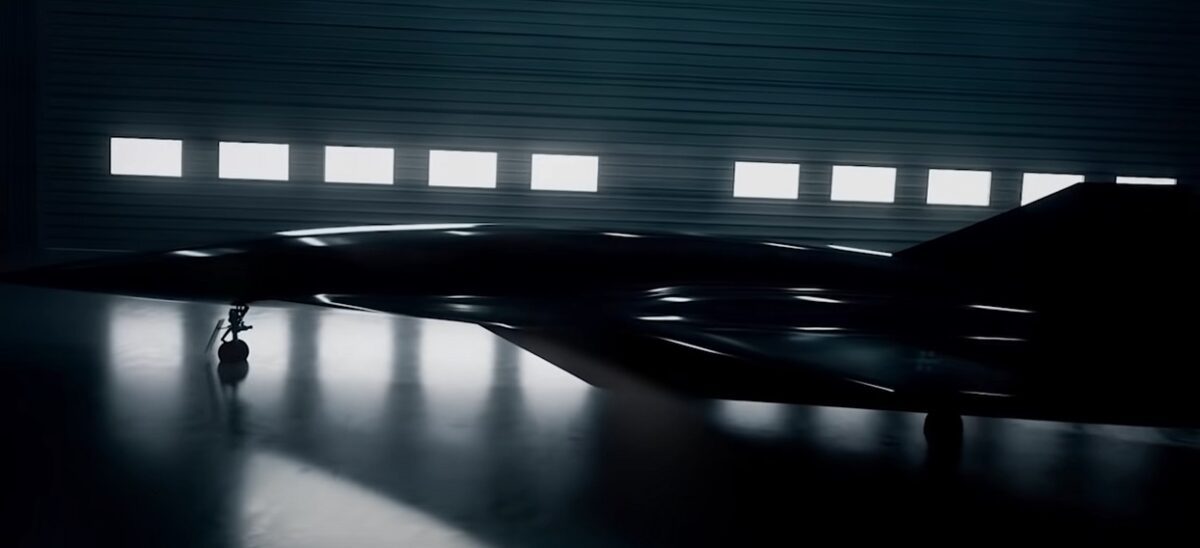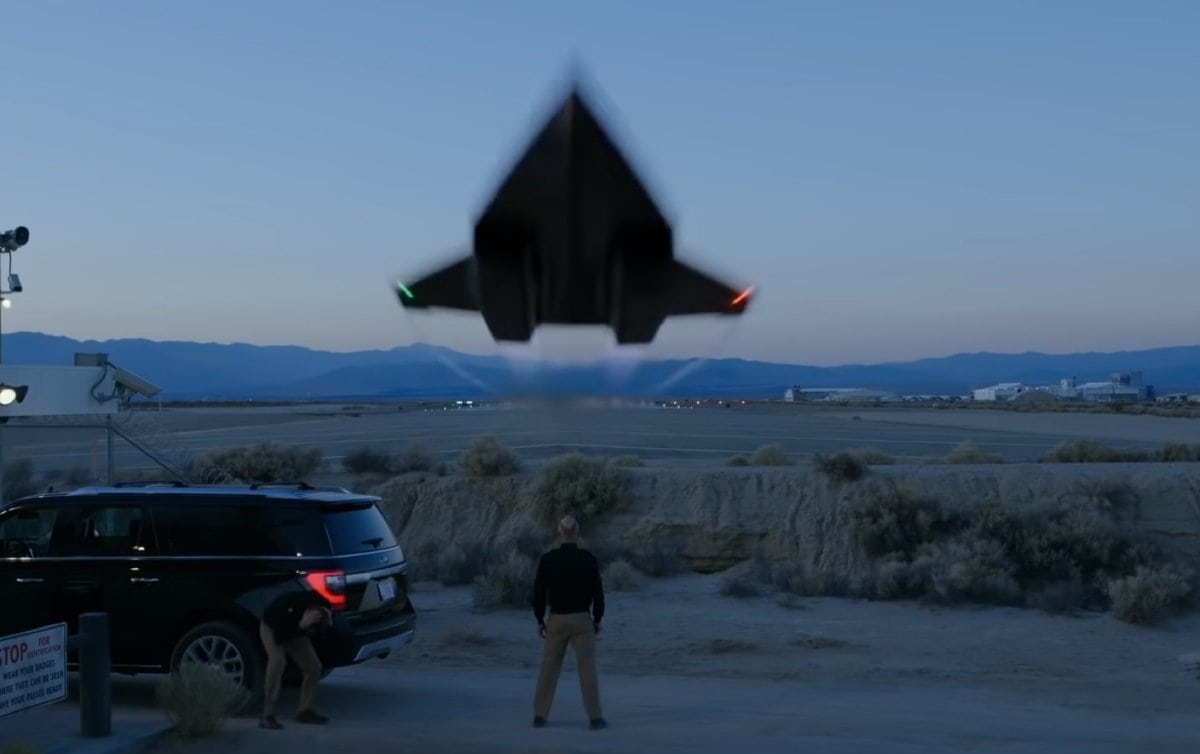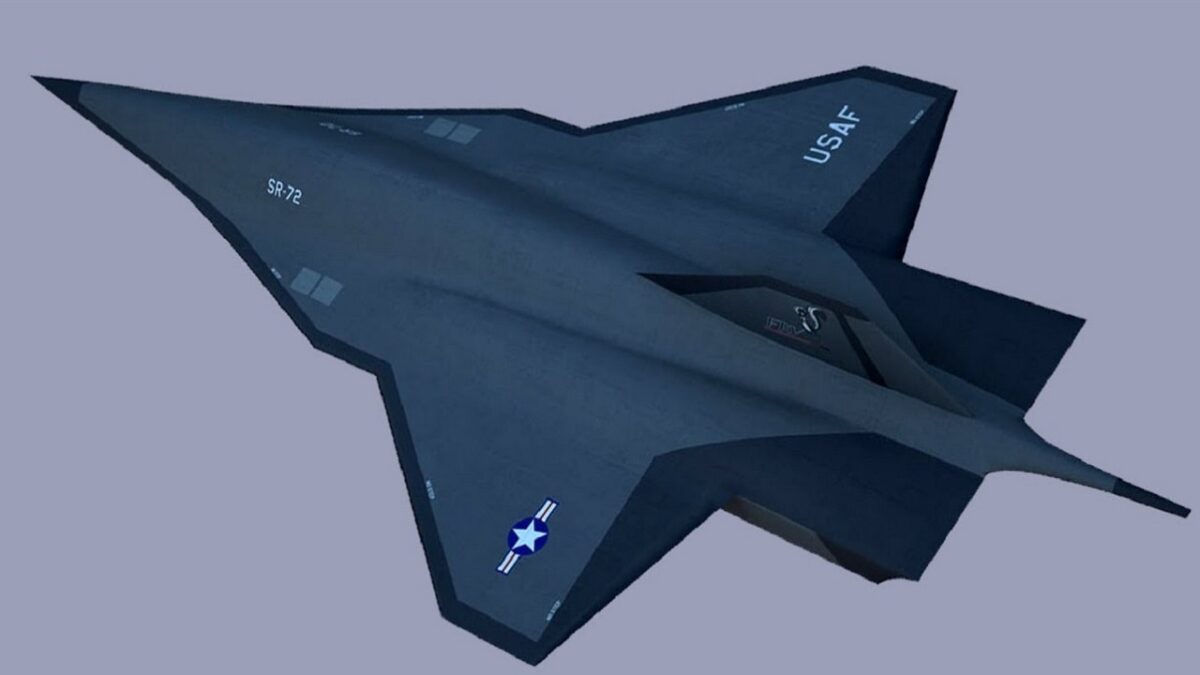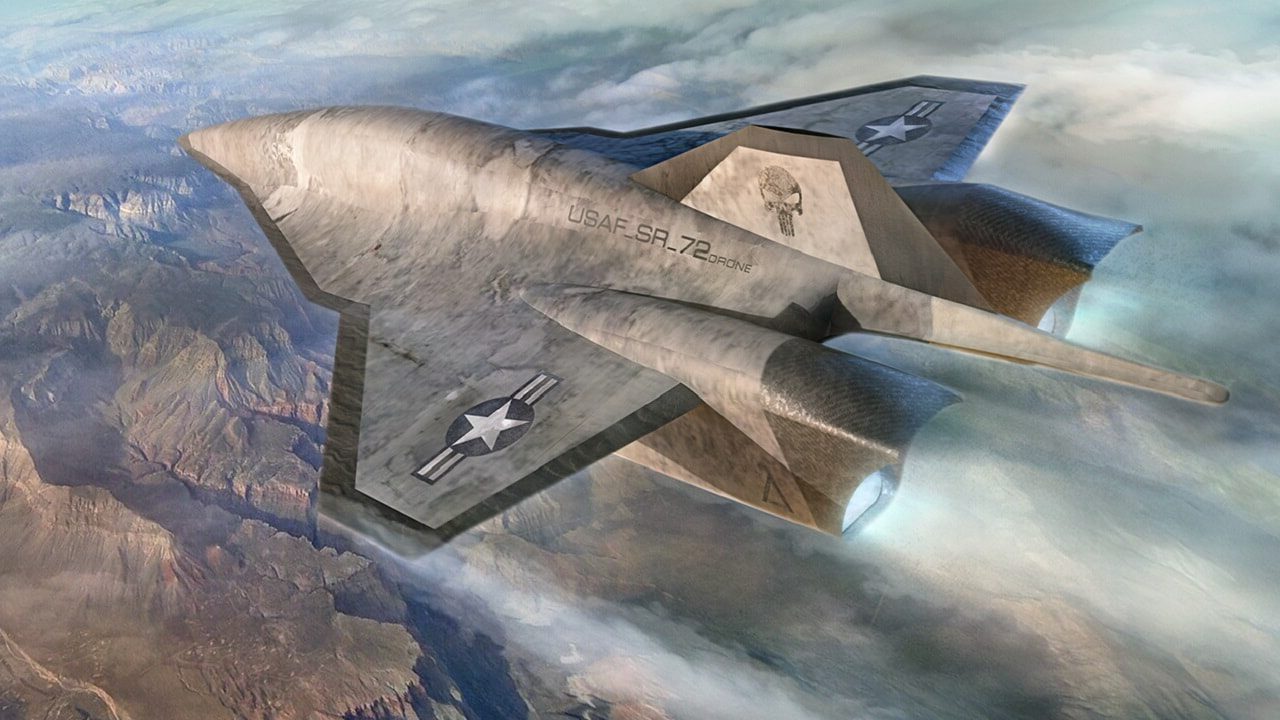The SR-72 Darkstar was a big part of the opening sequence of Top Gun: Maverick – hitting a crazy Mach 10. And there is a lot of evidence to suggest that it may be real in some capacity after all, explains defense expert and Marine veteran Alex Hollings: Last month, Sandboxx News broke the story that Lockheed Martin’s legendary Skunk Works team was directly involved in the development of a full-sized mockup of the hypersonic Darkstar aircraft featured in Top Gun: Maverick. The story was cited all around the world and the video of our interview with Top Gun’s producer and director, Jerry Bruckheimer and Joe Kosinski, has already racked up over 1.3 million views on YouTube alone.
We reached out to Lockheed Martin about the aircraft, and while they were willing to confirm their involvement, Skunk Works lived up to its secretive reputation by offering us little more than a wink and a nod.
Hypersonic is a term used to refer to weapons or aircraft that can travel at speeds in excess of Mach 5 or around 3,838 miles per hour. By combining maneuverability with this degree of speed, hypersonic missiles are considered impossible to intercept using current missile defense systems… which suggests hypersonic aircraft would be similarly difficult to bring down.
There seems to be much more to this story than a cool-looking imaginary airplane, and the truth is, Darkstar may not be as fictional as you think. In fact, Lockheed Martin has been working on just such an aircraft for a long time now… And although they’ve purged their website of any mention of it, we managed to dig up some interesting bits of evidence.
Top Gun‘s Darkstar appears to be modeled after previous Lockheed renders of the SR-72
Top Gun: Maverick was a sequel some-36 years in the making, but in a way, Darkstar was a long-awaited sequel in itself. As we discussed when Top Gun‘s toy line first dropped in 2020, Darkstar bears a striking resemblance to previous renderings of Lockheed Martin’s highly anticipated follow-up to the legendary SR-71 Blackbird, known to many simply as the SR-72.
At the time, we had no idea that Lockheed Martin was involved with the film. Nevertheless, aside from the switch from a single vertical tail to a pair of them, the similarities were convincing enough to lead us to believe that Paramount at least had the SR-72 in mind when designing their fictional aircraft.
Here’s the thing, though… While Top Gun: Maverick takes place in a fictional universe where pilots like Maverick are hailed as heroes despite some very problematic behavior and a complete disregard for safety regulations, there’s some strong evidence to suggest that an aircraft very much like Darkstar really is in development with the U.S. Air Force. Not only that, but Lockheed Martin’s Skunk Works was even listed by the branch as one of the few firms that they believed had the expertise required to pursue the development of such a reusable hypersonic aircraft (alongside Boeing and Raytheon).
And to make matters even more interesting, Lockheed Martin recently announced a significant success in testing the same sort of hypersonic propulsion systems leveraged by Darkstar in the movie, making the depiction of the Mach 10 aircraft seem a little less like science fiction, and a little more like a glimpse into the near future.
The real hypersonic strike aircraft the Air Force is developing might be a lot like Darkstar
Hidden within the long list of hypersonic weapon programs drawing funds from Pentagon coffers, the Air Force Research Laboratory’s (AFRL) Mayhem Program may seem at first glance like just another missile effort. But it’s actually aimed at developing the holy grail of hypersonic flight: a dual-cycle scramjet propulsion system capable of propelling larger payloads for longer distances than existing systems while taking off and landing like any other airplane. The Air Force’s contract documentation does not specify the “existing systems” it’s referring to.
Scramjets, or supersonic ramjets, aren’t exactly new technology — they’ve been under testing for decades, but to date, no nation has ever managed to field an operational scramjet in a missile or aircraft. These engines work by using the immense force of the air flowing into the jet inlet at supersonic and higher speeds to compress the air inside the engine before it’s mixed with fuel and detonated out the back for propulsion. According to Lockheed Martin, this effort could propel an aircraft to a sustained speed of Mach 6, or a bit better than 4,600 miles per hour.

Possible Image of SR-72. Image Credit: YouTube Screenshot.
Because scramjets allow the air to travel through the engine at supersonic speeds, they’re capable of maintaining much higher velocities than traditional jet engines… but, because they need that high-pressure airflow to create compression, they can’t function well at the low speeds required for normal operations like take-off and landing. As such, even the most advanced scramjets in testing today are carried aloft by aircraft and then launched using rockets before the scramjet comes online.
Although Mayhem is regularly referred to as a missile program, a closer look at the AFRL’s issued Request for Information (ROIs) suggests Mayhem is more likely aimed at fielding an uncrewed, reusable hypersonic drone platform. The ROI released by the Air Force calls for a drone capable of conducting two different specified mission sets: strike operations and intelligence, surveillance, and reconnaissance, or ISR, missions. In other words, Mayhem is aiming to field an aircraft that can take off and land like a normal jet while achieving and maintaining hypersonic speeds during the midcourse of its flight. The ROI goes on to specify two different types of ordnance this new aircraft would carry: an “area effect payload,” and a “large unitary payload.”
The Mayhem effort, however, aims to create dual-cycle engines that can function at low speeds until the aircraft is flying high enough and fast enough for the scramjet to take over… just like Darkstar is seen doing during Maverick’s hypersonic test-flight depicted in the movie.
Mayhem’s formal name recently changed from “Expendable Hypersonic Multi-Mission Air-Breathing Demonstrator” to “Hypersonic Multi-mission ISR and Strike,” and the effort has also been referenced as a “Multi-Mission Cruiser.” This strongly suggests that we’re not talking about a missile you fire at a target and forget about. The removal of the word “expendable” in conjunction with the “multi-mission” moniker both suggest Mayhem aims to field a reusable, autonomous platform that leverages what will likely be the world’s first dual-mode or turbine-based combined cycle (TBCC) hypersonic propulsion systems.
And as we mentioned before, Lockheed Martin is not only one of the few companies the Air Force Research Laboratory thinks could accomplish this feat, but has actually been leaving clues about a hypersonic SR-72 that looks like Darkstar for years now.
Lockheed Martin announced a successful hypersonic scramjet test just three months ago
In March of 2022, the Defense Advanced Research Projects Agency, Aerojet Rocketdyne, and Lockheed Martin conducted a successful flight test of the Hypersonic Air-breathing Weapon Concept (HAWC), though the success wasn’t reported until the following month to limit tensions between the United States and Russia.
The test was actually the second success of the HAWC program, but the first of the Lockheed Martin scramjet system. A previous success, recorded in September of 2021, had come from the same HAWC program but had leveraged a Northrop Grumman-sourced scramjet. As we highlighted at the time, these successes suggest that the United States is now leading the way in fielding weapons that use these high-speed air-breathing propulsion systems.

SR-72, maybe. Screenshot from Top Gun 2 Trailer.
The United States has committed to only developing conventional (non-nuclear) hypersonic weapons, which creates a number of challenges not found in the deterrent systems fielded by America’s competitors. Perhaps the most significant one is targeting: nuclear weapons have huge blast radiuses, allowing for less accurate weapons. A conventional hypersonic missile has to be far more accurate in order to destroy its intended target.
While these non-nuclear hypersonic weapons can be strategically valuable, they’re also incredibly expensive — which has led some to question the value of developing these missiles in the first place. After all, hypersonic weapons’ claim to fame is the ability to defeat air defenses, but the same can be accomplished through a high volume of slower-moving, less expensive systems. If you overwhelm an enemy’s air defense capabilities, some of your missiles will find their target, even when we’re talking about subsonic cruise missiles like the Tomahawk.
But, a hypersonic strike aircraft could ferry less-expensive, slower-moving weapons into enemy airspace at hypersonic speeds, preventing interception in the same way missiles do. Such an aircraft could deploy a low-cost conventional payload and then scram(jet) out of harm’s way to land and re-arm. By doing so, you get all the offensive capabilities of hypersonics without having to deposit your shiny new scramjet in the foundation of your target’s house.
The Mayhem program is oriented toward building larger scramjets capable of flying larger payloads multiple times, and Lockheed Martin appears to have a finger in that pie.
Lockheed Martin’s recent posts about Darkstar suggest there could be some truth behind the movie’s magic
On June 3, Lockheed Martin’s Twitter account posted a short video about Darkstar that featured a Skunk Works conceptual designer identified only as “Jim.” In the video, Jim explains how he can’t talk about “most of the stuff” that he works on.
It’s the last statement made in the 30-second video that may suggest there’s some element of truth behind the aircraft’s design.
“My name is Jim, I helped develop the Darkstar aircraft and in real life, I conceptualize the future here at Lockheed Martin Skunk Works.”
But lest you think we’re simply reading too much into Jim’s statement, Lockheed Martin’s Darkstar webpage does a lot more than wink at the possibility that Darkstar could share some DNA with real classified programs. It comes right out and says so.

SR-72. Image Credit – Artist rendering.
“When the Top Gun: Maverick team was looking to push the envelope and stand true to Maverick’s Need for Speed, Skunk Works was their first call. With the Skunk Works expertise in developing the fastest known aircraft combined with a passion and energy for defining the future of aerospace, Darkstar’s capabilities could be more than mere fiction. They could be reality…”
-Lockheed Martin’s Darkstar webpage
The website does overtly explain that the Darkstar itself is not a real aircraft, despite Skunk Works helping Paramount’s production team build a full-sized mockup of the notional jet for filming. But they go on to explain that hypersonic flight is an area of significant focus for the firm.
“Darkstar may not be real, but its capabilities are. Hypersonic technology, or the ability to travel at 60 miles per minute or faster, is a capability our team continues to advance today by leveraging more than 30 years of hypersonic investments and development and testing experience.”
-Lockheed Martin’s Darkstar webpage
But the real clues might have actually surfaced years ago
All the way back in 2018, Lockheed Martin’s Vice President of Strategy and Customer Requirements in Advanced Development Programs, Jack O’Banion, spoke at the SciTech Forum, held by the American Institute of Aeronautics and Astronautics in Florida. During the event, O’Banion projected an artist’s rendering of the SR-72 on the screen behind him and discussed the aircraft as though it already existed and had been seeing successes in testing.
“Without the digital transformation, the aircraft you see there could not have been made,” O’Banion told the audience in 2018.
“We couldn’t have made the engine itself — it would have melted down into slag if we had tried to produce it five years ago. But now, we can digitally print that engine with an incredibly sophisticated cooling system integral into the material of the engine itself, and have that engine survive for multiple firings for routine operation.”
When pressed about these statements by Bloomberg, O’Bannion doubled down.
“The aircraft is also agile at hypersonic speeds, with reliable engine starts,” he told them.
His statements really seemed to suggest that the SR-72 wasn’t just a paper plane (or an aircraft that exists as a design only), but rather something that had already seen some degree of testing. And there’s evidence to substantiate that claim.
A year prior, in 2017, Aviation Week had reported that what appeared to be an unmanned subscale SR-72 technology demonstrator was spotted flying near the U.S. Air Force’s Plant 42 at Palmdale. This is the same location as Skunk Works’ headquarters. Aviation Week reached out to Lockheed Martin’s Orlando Carvalho, executive vice president of aeronautics, at the time.
“Although I can’t go into specifics, let us just say the Skunk Works team in Palmdale, California, is doubling down on our commitment to speed,” he told Aviation Week in 2017.
“Hypersonics is like stealth. It is a disruptive technology and will enable various platforms to operate at two to three times the speed of the Blackbird… Security classification guidance will only allow us to say the speed is greater than Mach 5.”
Lockheed Martin deleted its SR-72 website right after Putin announced the world’s first operational hypersonic weapons
Lockheed Martin launched a page devoted to its SR-72 in 2013 and then updated it in 2015. In the same year Popular Science did a cover story about the program which was also featured on Lockheed Martin’s page.
On March 1, 2018, Russian President Vladimir Putin delivered what has become an infamous speech, in which he announced the world’s first operational hypersonic weapon, the Kh47M2 Kinzhal, and Russia’s plans to field the nuclear Avangard hypersonic boost-glide weapon. This address has since been seen as the onset of the modern hypersonic arms race.
“No one has listened to us,” Putin said. “You listen to us now.”
Despite the Kinzhal not being what it was said to be, Putin’s remarks left many around the world concerned about the capability gap these new weapons presented.
Interestingly, immediately after Putin announced Russia’s hypersonic weapons, Lockheed Martin removed all mention of their hypersonic aircraft program, the SR-72, from their website. The URL now redirects to Lockheed’s news page. However, you can still access the page using the Wayback Machine (an internet archive that saves old websites).
From March of 2018 forward, you could find no mention of the SR-72 anywhere on the site until 2022, when people began referencing the SR-72 in relation to Darkstar.
Fortunately, we can see what used to be there thanks to the Wayback Machine archives.
According to the now-defunct SR-72 website, Lockheed claimed their scramjet-powered aircraft could be in service by 2030. And it’s worth noting that they mention working with Aerojet Rocketdyne to that end. Aerojet Rocketdyne is the same firm that Lockheed worked with for their recent successful scramjet test for the HAWC program.
“A hypersonic plane does not have to be an expensive, distant possibility. In fact, an SR-72 could be operational by 2030. For the past several years, Lockheed Martin Skunk Works® has been working with Aerojet Rocketdyne to develop a method to integrate an off-the-shelf turbine with a supersonic combustion ramjet air breathing jet engine to power the aircraft from standstill to Mach 6,” Lockheed Martin’s website stated in 2018.
“The result is the SR-72 that Aviation Week has dubbed ‘son of Blackbird,’ and integrated engine and airframe that is optimized at the system level for high performance and affordability.”
So is Darkstar a real hypersonic aircraft?
The short answer is no. Darkstar is a full-sized mock-up designed specifically for the needs of Top Gun: Maverick. Jerry Bruckheimer claimed the U.S. Navy told him China re-oriented a spy satellite to get a closer look at their mock-up, which may just be Hollywood hype… or it could be a sign that while Darkstar isn’t real, there may be something like it that is.
The most evident difference between Darkstar and the SR-72 concept is Maverick himself. Since its inception, the SR-72 has been envisioned as an uncrewed platform that doesn’t need a pilot on board. While hypersonic flight is entirely feasible for human biology, it still represents some real challenges that can be skipped when developing a drone.
As we’ve learned from our discussions with Hermeus, a firm working to develop reusable hypersonic aircraft for commercial and defense purposes, the G-forces inherent to hypersonic flight wouldn’t be a significant issue for humans on board as long as the progression to high Mach speed was somewhat gradual. After all, astronauts regularly see speeds in excess of Mach 25 upon re-entry without any ill effects. And while hard maneuvering could present a problem, the biggest hurdle would be devising a way for pilots to survive ejections at speeds in excess of 4,000 miles per hour from altitudes of 100,000 feet or more.
Having a pilot on board also comes with a lot of added weight, from life support systems to controls and displays, an ejection seat and cockpit canopy, etc.
But if Lockheed Martin is continuing work on the SR-72 concept under the Air Force Research Laboratory’s Mayhem banner, China may have been trying to catch a glimpse of that when peeking at Darkstar. After all, if Lockheed Martin continued work on the SR-72 in secret since 2018, there’s probably some awfully interesting stuff worth trying to peek at.
For all we know, the SR-72 may already exist… or it may still be on the drawing board somewhere in Palmdale. In either case, one thing is for certain: Lockheed Martin’s Skunk Works has its sight set on doing much more than faking hypersonic flight for the big screen.

